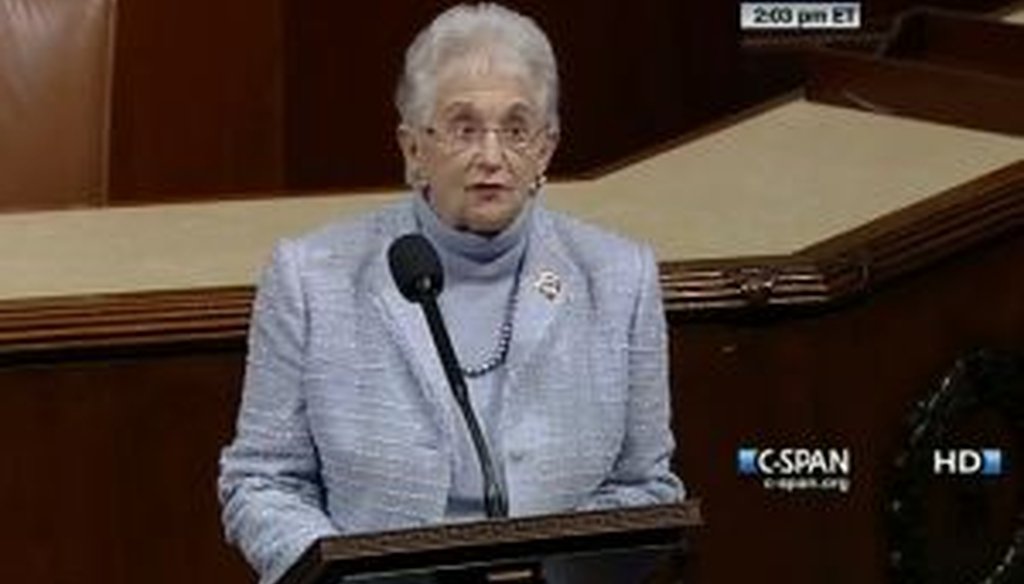

Our only agenda is to publish the truth so you can be an informed participant in democracy.
We need your help.


Rep. Virginia Foxx, R-N.C., said during a floor speech that there are 3.6 million jobs sitting vacant, partly because of a mismatch in job skills. We checked to see if she was correct.
Rep. Virginia Foxx, R-N.C., recently took to the House floor to tout a bill she’s sponsoring that would change the structure of job training programs. She warned that the economy faces a paradox -- despite historically high unemployment rates, many jobs are going vacant.
"There are 3.6 million jobs sitting vacant, in part because there aren’t enough qualified applicants to fill them," Foxx said in the March 12, 2013, speech.
To check Foxx’s claim, we turned to data from the Bureau of Labor Statistics, the federal government’s scorekeeper on employment data.
We easily found the source of her 3.6 million figure. It comes from a monthly survey called the Job Openings and Labor Turnover Survey, or JOLTS. The most recent seasonally adjusted data at the time of Foxx’s speech covered January 2013. It showed that there were just under 3.7 million job openings in January, which was up slightly from 3.6 million in December 2012.
So Foxx essentially got the number right. However, her use of the term "sitting vacant" and her warning about a "shortage of qualified applicants" suggests that employers are having trouble filling these 3.6 million jobs. A close look at the survey reveals it doesn’t actually support that thesis.
The bureau’s official definition of a "job opening" is "a specific position of employment to be filled at an establishment" that satisfy these conditions: "there is work available for that position, the job could start within 30 days, and the employer is actively recruiting for the position."
But there are always job openings -- even in a healthy economy. In a phenomenon known as "churn," people change jobs. Just because their old job is unoccupied when the BLS takes its monthly data snapshot doesn’t necessarily mean that the employer is having trouble filling the job. Rather, the employer could simply be going through the process of hiring, with the job filled a month later.
The data from this survey "has important limitations," said Steven J. Davis, an economist at the University of Chicago Booth School of Business, because it "provides little information about the distribution of vacancy durations" and "no direct information about the reason why some job openings take a long time to fill."
In some ways, vacancies are actually a hallmark of a healthy economy. Job openings often arise either because someone leaves one job for a better one, or because a company is hiring new workers. Both are positive signs. If you look at the monthly December job opening totals going back a decade, the years just prior to the recession had the most job openings, while the years during and immediately after the recession hit had the least job vacancies:
2012: 3.6 million
2011: 3.5 million
2010: 2.9 million
2009: 2.5 million
2008: 3.2 million
2007: 4.0 million
2006: 4.4 million
2005: 3.9 million
2004: 3.5 million
2003: 2.9 million
But while the number Foxx used doesn’t provide much support for her claim, other evidence, both anecdotal and statistical, suggests that she has a point that there’s a problem with unfilled jobs today.
The most solid evidence for a lengthening of job vacancies comes from a study by Davis, R. Jason Faberman and John C. Haltiwanger. It found that the time before a vacancy is filled has expanded from 15 days in 2009 to 23 today. As a result, the job vacancy rate and the unemployment rate, which historically have moved in tandem, began to diverge during the most recent recession and have not yet returned to their historical pattern.
Why is this happening? Foxx’s office provided links to a variety of news reports that suggest a mismatch between applicants’ job skills and the ones employers are seeking. Economists agree that that is part of the issue, particularly with high-skill jobs. But it’s probably not the only reason.
For instance, there appears to be a "hiring paralysis" among employers who are acting with unusual caution because they are uncertain whether the economy will remain strong rather than stagnating, according to economists and hiring professionals quoted in the New York Times earlier this year. This has sometimes led to employers piling on extra tests and rounds of interviews as a way of stalling, experts told the Times.
Our ruling
Foxx said, "There are 3.6 million jobs sitting vacant, in part because there aren’t enough qualified applicants to fill them." She’s right that there are 3.6 million vacancies and she's right that there aren't enough qualified job applicants, but she wrong to link the two because that statistic doesn’t take into account how long a job has been open. Still, there is strong evidence that the duration of job vacancies has grown since the onset of the most recent recession, and the skills mismatch Foxx cites is likely part of the reason. We rate her claim Mostly True.
Virginia Foxx, House floor speech, March 12, 2013
Bureau of Labor Statistics, Job Openings and Labor Turnover monthly news release, January 2013
Steven J. Davis, R. Jason Faberman and John C. Haltiwanger, "The Establishment-Level Behavior of Vacancies and Hiring," Jan. 31, 2013
Bureau of Labor Statistics, glossary of labor and employment terms, accessed March 12, 2013
New York Times, "With Positions to Fill, Employers Wait for Perfection," March 6, 2013
New York Times, "A Shift Toward Higher Job Vacancy Rates" (graphic), March 6, 2013
Email interview with Tara Sinclair, economist at George Washington University, March 13, 2013
Email interview with Steven J. Davis, economist at the University of Chicago Booth School of Business, March 13, 2013
In a world of wild talk and fake news, help us stand up for the facts.
